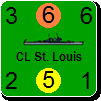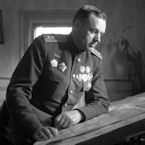janh
Posts: 1216
Joined: 6/12/2007
Status: offline

|
On a side note...
quote:
ORIGINAL: Klydon
Remember that the point of no Lvov pocket is to slow the German advance down, especially in the south. We have some talented German players around, but I don't recall seeing one getting to Rostov/Voronezh/Moscow by turn 12 against even an average Russian opponent and certainly not a German who has given up early activiation of the Rumanians and entrapping a ton of units on a giant Lvov pocket. In addition, there are likely going to be restrictions on HQ buildups, further slowing the German advance.
Hmmh, it would seem as if the dynamics of the op-tempo has some strange skew? In the early days, the German rush is apparently fast, but then it seems to slow more rapidly than it did once past the initial phase, when the rush through disorganized Soviet forces in the south should happen?
It could have two reasons: For one, both side appear to be husbanding their forces a little better than it perhaps was the case back then. Perhaps not actually not in "permanent losses", although the Soviets and Germans were quite worn down at the time of Typhoon (for example many of the German Divisions were rather skeletons of their former self, esp. the Panzers, and the Soviet Army was also down to less than 3 Mio men, or was even below 2.8 Mio?). I think this is something you commonly see in computer games compared to actual history, likely in part because sitting here you have a perfect picture and control of everything, and if at all, the enemy numbers are off by FOW -- you commonly know your forces and losses in detail, and there is no missing or delayed reports, no commanders returning wrong numbers or making mistakes in assessing the combat state of his forces etc. Same in WitP. In part this saving of own forces seems to be due to having no real consequences here for the player, versus the quest for success, promotion or fear of reprimands of any sorts for commanders back then.
A second reason could be the generally totally different dynamics in the South induced by a totally different opening. Historically, the forward movement was characterized by a lot of Russian counterattacks against the advancing spearheads as well as the Infantry, usually during their movements and less so when settled down to prepared defensive positions (such as the deliberate and hasty attacks mimic in the game more closely than the ambush or meeting engagements on more even terms -- see the Glantz Book "Standing Fast: German Defensive Doctrine on the Russian Front...", http://www.cgsc.edu/carl/resources/csi/wray/wray.asp#orgin that talks about he Soviet's early counterattack doctrines, the resulting defensive fighting of the German columns, or the tank fright of the Infantry attacked by KV or T-34 etc).
During the first phase, the situation for the Russians in the South remained rather stable. Some chaos and mingling of the frontlines of both sides, due to the forth and back, but not a more complete breakdown as caused by AGN or AGC. Hence, up until the 2nd phase, the closing and elimination of the Kiev pocket, advance was comparably slow but steady for AGS (quite different from the fighting of AGN and AGC). Once the Kiev pocket was closed, the Soviet breakdown of adjacent sectors and rear followed suit and disorder gave a few weeks in which the Germans could again rush rather fast thru the vacuum and chaos of the retreating Soviet remnants, despite having themselves been attrited quite significantly in the first few weeks. I'd consider that the 3rd phase, which ended with the Soviets having had enough time to rally east of the Kursk-Rostov line. By stiffening Soviet resistance and the growing exhaustion and attrition of the Germans, and them outrunning their supply lines, the German advance was checked. So the dynamics was "steady advance, slow pocketing advance, a steady advance or even fast rush, and a grinding halt at the end".
What we see presently is "a fast closing of the Lvov pocket, a consequently fast rush towards the Djenpr through the chaos following immediately this evaporation of the Soviet Southern Armies (during which time the Soviets reorganize and stiffen resistance), and a slow but steady advance afterwards, yet in a sufficiently re-stabilized frontline situation, that a quick rush is not in plain sight. I suppose crushing blow must fall later and closer to the Djenpr if you look for an ensuing rout and vacuum to drive the Panzers thru fast and far towards Rostov.
Creating that rout and vacuum in the first week, and allowing the Soviets 3-6 weeks to send all reinforcements South (which historically probably went mostly north and center, as the Southern Russian Armies were still rather intact before Kiev compared to the others), probably changes the overall dynamics of the battle for AGS such that it cannot repeat the historical feat. That makes it indeed more interesting to see what happens if the Lvov opening is replaced by sharper fighting for a couple of weeks, before a breakdown occurs -- i.e. assuming, that the Soviet player will also not send exceeding reinforcements into the Southern rear with his hindsight of the Kiev disaster...
< Message edited by janh -- 10/20/2011 11:48:04 AM >
|
 Printable Version
Printable Version
















 New Messages
New Messages No New Messages
No New Messages Hot Topic w/ New Messages
Hot Topic w/ New Messages Hot Topic w/o New Messages
Hot Topic w/o New Messages Locked w/ New Messages
Locked w/ New Messages Locked w/o New Messages
Locked w/o New Messages Post New Thread
Post New Thread